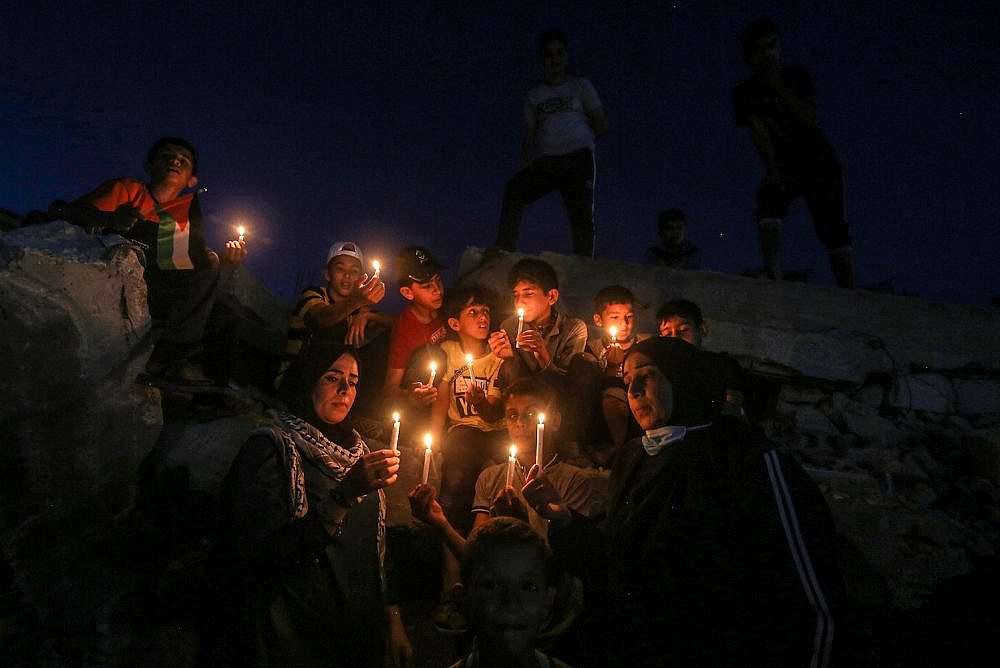Despite all these crimes Israel remains untouched due to the blind support of US, UK, France and other European countries and the Arab tyrants
Friday, 28 May 2021
More than 13 years ago, between 27 December 2008 and 18 January 2009, Israel unleashed its carnage on the besieged and starving Palestinians in Gaza. As usual the United States, Britain, France and Russia provided Israel enough time to continue the killings and destruction.
Their response remains unchanged even during Israel’s latest May 2021 carnage.
Gaza is a small beach side strip of around 365 sq. miles by the Mediterranean Sea. Sandwiched between Egypt and Israel this territory with about two million Palestinians is one of the most densely populated areas in the world.
Most of the inhabitants are refugees who owned lands and homes in what we now call Israel. They were chased out at gun point by Jewish terror gangs who committed massacre after massacre of Palestinians and grabbed their lands to set up the Jewish state of Israel in Palestine in 1948.
During the June 1967 Israeli war of aggression, Gaza was brought under its occupation. Since then, the people there were subjected to untold oppression, cruelties and miseries besides daily killings, arbitrary arrest and torture. Decades of Israeli oppression and humiliation produced angry Palestinians most of whom are fighting back with limited means.

Unable to face the fierce Palestinian opposition, Israel withdrew its forces from Gaza after 38 years in 2005 and handed over control of the Rafah border, Gaza’s sole contact with the outside world, to Egypt while Palestinian forces, monitored by European Union officials, too were stationed.
Almost four decades of systematic Israeli oppression and repeated border closures have driven Gazans to poverty and inevitably around 80% of the population depends on food aid for day-to-day subsistence. Without such aid they would die in a matter of days.
Elections
In a spotless free election held in January 2006, under the supervision of former US President Jimmy Carter who described it as free and fair, Hamas was elected with an overwhelming majority.
Israel, US and their European and Arab collaborators who did not want democracy in the Middle East wanted Hamas crushed. Though Hamas was elected by people, Israel, backed by US and Europe, stopped all donations and cut off the flow of all money to starve Palestine into submission. The Arab regimes too joined this financial blockade knowing very well the misery they were causing to the Palestinians who needed this money to keep body and soul together.
In the midst Israel, under the guise of trying to free a captured soldier, bombed Gaza Strip in June 2006 with its F-16 fighter planes, helicopter gunships and artillery fire from tanks surrounded and turned Gaza into a virtual slaughter house. Within days roads, bridges, power plants, water supply, universities, schools, hospitals, play grounds, mosques and even tombs and ministry buildings were bombed and destroyed causing untold misery to the people already starving. In violation of international law, Israel started mafia-style abduction of Hamas cabinet ministers, mayors and parliamentarians. Egypt joined Israel in closing the border and virtually sealed and cut off Gaza from the rest of the world.
Since June 2007, 90% of Gaza’s local industries too were forced to shut down, leaving 70,000 labourers jobless. There was no fuel to keep the plant running because Israel imposed a complete lockdown with no movement in or out of the Gaza Strip for people, or any kind of shipments of vital food, fuel supplies and medicines.
It was a slow death. Palestinians in Gaza and even in the West Bank were made virtual prisoners in their own homes and in a dire economic situation while Israel continued its air strikes in the densely populated city. This was a grave war crime and it should be pointed out that in the aftermath of World War II German leaders were sentenced to death for lesser crimes.
This situation continued for 20 long months until 17 January 2008 when Israel imposed a complete blockade and shut down Gaza’s only power plant plunging the entire territory into chaos. They were only allowed to breathe the air which Israel could not blockade.
People started queuing for bread, but there was no bread as it cannot be made without electricity. Connections with the outside world started fading as mobile phones and laptops ran out of battery power. There was no water because the pumps needed electricity. People could not go to work because there was no fuel for cars and buses. Hospitals with generators ran out of fuel to power them, halting all surgery procedures. In desperation, Palestinians tried to enter Egypt through the Rafah crossing, but the Egyptian border guards drove them out. Over 1,000 Palestinians went out to the streets begging the world to end this cruel enforced starvation to death.
Israeli peace activist Uri Avnery said, “The message of Jews, the US and Europe to Palestinians is that you will reach the brink of hunger, and even beyond, if you do not surrender. You must remove the Hamas government and elect candidates approved by Israel and the US.
It was on these starving Palestinians in Gaza, Israeli unleashed its military might, from 27 December to 18 January 2009, using US supplied latest of bunker buster missiles, F16 bombers and other latest of weapons.
During the 22 days of its carnage Israel killed, 1,334 Palestinians, one-third of them children, injured 5,450, one-third of them children, displaced 100,000, made homeless 50,000, destroyed 4,100 residential homes and buildings, damaged 17,000 (together accounting for 14% of all buildings in Gaza), destroyed 29 educational institutions, destroyed or damaged 92 mosques, destroyed 1,500 shops, factories and other commercial facilities, 20 ambulances, ruined 35-60% of agricultural land and caused an estimated damage of $ 1.9 billion in total estimated damages.
Israel remains lawless and arrogant. Champions of human rights in Washington, London, Paris and the so-called brothers in the Middle East had no time for Palestinians.
The United Nations prepared two reports on Israeli war crimes on Gaza between 27 December 2008 to 18 January 2009. First was by UN High Commissioner for Human Rights Navi Pillai while the second was by South African jurist Richard Goldstone who presented his report in mid-September 2009.
In her report UNHRC Commissioner Navi Pillai, lambasting the ‘nearly total impunity’ for the violations, stated, “There is significant evidence that Israeli forces violated international law and human rights in their invasion of Gaza compounded by the blockade that the population of Gaza endured which continues.”
These violations included arbitrary detention, torture and ill-treatment, extrajudicial execution, forced eviction and home demolition, settlement expansion and related violence and restrictions on freedom of movement and expression.
“While these violations are of deep concern in their own right, the near total impunity that persists for such violations are of grave concern and constitutes a root cause for their persistence,” Navi Pillai said.
These observations were reiterated by yet another UN Fact-Finding Mission report which concluded that Israel committed “war crimes and possibly crimes against humanity”. The members of the Fact-Finding Mission included Justice Richard Goldstone, Head of Mission; former judge of the Constitutional Court of South Africa; former Prosecutor of the International Criminal Tribunals for the former Yugoslavia and Rwanda.
The report, called Goldstone report concluded that the Israeli military strikes was directed at the people of Gaza as a whole, in furtherance of an overall and continuing policy aimed at punishing the Gaza population, and in a deliberate policy of disproportionate force aimed at the civilian population. The destruction of food supply installations, water sanitation systems, concrete factories and residential houses was the result of a deliberate and systematic policy which has made the daily process of living, and dignified living, more difficult for the civilian population.
Despite all these crimes Israel remains untouched due to the blind support of US, UK, France and other European countries and the Arab tyrants. And now comes the eleven-day Israeli war crimes once again in Gaza. Once again Israel will get away from these war crimes with US-European support.







![Protesters at solidarity rallies in Sao Paulo, Brazil, May 2021. [Fatma Abu Watfa]](https://i1.wp.com/www.middleeastmonitor.com/wp-content/uploads/2021/05/Protesters-at-solidarity-rallies-in-Sao-Paulo-Brazil-May-2021.-Photos-by-Fatma-Abu-Watfa.jpg?resize=1199%2C800&quality=85&strip=all&zoom=1&ssl=1)


![Protesters at solidarity rallies in Sao Paulo, Brazil, May 2021. [Fatma Abu Watfa]](https://i1.wp.com/www.middleeastmonitor.com/wp-content/uploads/2021/05/2-Protesters-at-solidarity-rallies-in-Sao-Paulo-Brazil-May-2021.-Photos-by-Fatma-Abu-Watfa.jpg?resize=933.5%2C623&quality=85&strip=all&zoom=1&ssl=1)
![Protesters at solidarity rallies in Sao Paulo, Brazil, May 2021. [Fatma Abu Watfa]](https://i0.wp.com/www.middleeastmonitor.com/wp-content/uploads/2021/05/3-Protesters-at-solidarity-rallies-in-Sao-Paulo-Brazil-May-2021.-Photos-by-Fatma-Abu-Watfa.jpg?resize=933.5%2C623&quality=85&strip=all&zoom=1&ssl=1)












